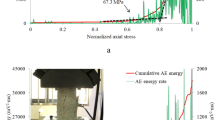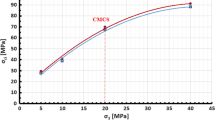Abstract
Accurately determining the crack initiation stress (CI) is of great importance to evaluate the stability of deep underground openings and the permeability of host rock in the near field. For this paper, uniaxial compression tests and increasing amplitude cyclic stressing tests were performed on four kinds of rocks with different porosities. The stress-strain data and acoustic emission (AE) data of these tests are analyzed to evaluate the applicability and accuracy of the existing methods for determining the CI. The results demonstrate that for marble and Beishan granite with low porosity, the lateral strain (LS) method is the simplest and most direct method to obtain the CILS. For high porosity sandstone, the result of lateral strain response (LSR) method is significantly smaller than that obtained by AE. The cumulative AE hits (CAEH) method heavily depends on the “S-shaped” characteristic of the cumulative AE hits curve, which limits its scope of application. The cumulative AE hits curve slope (CAHS) method, which determines the key inflection point of the cumulative AE hits curve by slope variation to determine the CICAHS, possesses the widest applicability and highest accuracy. The CI/UCS ratios of rocks with similar grain sizes decreases with increasing porosity. For Beishan granite, the average CICAHS is less than that of CILS. They are 0.43 UCS and 0.53 UCS, respectively. According to the residual strain data from the cyclic loading tests, the two crack initiation thresholds of Beishan granite can be clearly identified. These two crack initiation thresholds represent different crack initiation sequences in grain boundaries and different minerals.


















Similar content being viewed by others
Abbreviations
- E :
-
Elasticity modulus
- v :
-
Poisson’s ratio
- AE:
-
Acoustic emission
- CC:
-
Crack closure stress
- CI:
-
Crack initiation stress
- CD:
-
Crack damage stress
- UCS:
-
Uniaxial compressive strength
- CVS:
-
Crack volumetric strain
- LS:
-
Lateral strain
- LSR:
-
Lateral strain response
- RCSR:
-
Relative compression strain response
- CAEH:
-
Cumulative AE hits
- CAHS:
-
Cumulative AE hits curve slope
- AEHC:
-
AE hits count
- RS:
-
Residual strain
- AS:
-
Axial stiffness
References
Akesson U, Hansson J, Stigh J (2004) Characterisation of microcracks in the Bohus granite, western Sweden, caused by uniaxial cyclic loading. Eng Geol 72(1):131–142
Andersson C, Martin CD, Stille H (2009) The Äspö pillar stability experiment: part II—rock mass response to coupled excavation-induced and thermal-induced stresses. Int J Rock Mech Min Sci 46(5):865–878
Brace WF, Paulding BW Jr, Scholz CH (1966) Dilatancy in the fracture of crystalline rocks. J Geophys Res 71(16):3939–3953
Basu A, Mishra DA (2014) A method for estimating crack-initiation stress of rock materials by porosity. J Geol Soc India 84(2014):397–405
Basu A, Mishra DA, Roychowdhury K (2013) Rock failure modes under uniaxial compression, Brazilian, and point load tests. Bull Eng Geol Environ 72:457–475
Cai M, Kaiser PK, Tasaka Y, Maejima T, Morioka H et al (2004) Generalized crack initiation and crack damage stress thresholds of brittle rock masses near underground excavations. Int J Rock Mech Min 41(5):833–847
Chen SW, Yang CH, Wang GB, Wei X (2016) Experimental study on the determination method of σcc, σci and σcd for granite under different confining pressures. J Northeast Univ 37(12):1789–1793
Chen Y, Watanabe K, Kusuda H, Kusaka E, Mabuchi M (2011) Crack growth in Westerly granite during a cyclic loading test. Eng Geol 117:189–197
Chen S, Wang G, Zuo S, Yang C (2021) Experimental investigation on microstructure and permeability of thermally treated Beishan granite. J Test Eval 49(2)
Diederichs MS (2007) The 2003 Canadian Geotechnical Colloquium: mechanistic interpretation and practical application of damage and spalling prediction criteria for deep tunnelling. Can Geotech J 44(9):1082–1116
Diederichs MS, Kaiser PK, Eberhardt E (2004) Damage initiation and propagation in hard rock during tunnelling and the influence of near-face stress rotation. Int J of Rock Mech Min 41(5):785–812
Eberhardt E, Stead D, Stimpson B, Read RS (1998) Identifying crack initiation and propagation thresholds in brittle rock. Can Geotech J 35(2):222–233
Eberhardt E, Stead D, Stimpson B (1999) Quantifying progressive prepeak brittle fracture damage in rock during uniaxial compression. Int J Rock Mech Min Sci 36:361–380
Fairhurst C, Cook NGW (1966) The phenomenon of rock splitting parallel to the direction of maximum compression in the neighborhood of a surface. In: Proceedings of the 1st congress of the international society of rock mechanics, Lisbon, pp 687–692
Ghasemi S, Khamehchiyan M, Taheri A et al (2020) Crack evolution in damage stress thresholds in different minerals of granite rock. Rock Mech Rock Eng 53:1163–1178
Heap MJ, Faulkner DR (2008) Quantifying the evolution of static elastic properties as crystalline rock approaches failure. Int J Rock Mech Min 45(4):564–573
Heap MJ, Vinciguerra S, Meredith PG (2009) The evolution of elastic moduli with increasing crack damage during cyclic stressing of a basalt from Mt. Etna volcano Tectonophysics 471(1):153–160
Hatzor YH, Palchik V (1997) The influence of grain size and porosity on crack initiation stress and critical flaw length in dolomites. Int J Rock Mech Min Sci 34(5):805–816
Lajtai EZ (1974) Brittle fracture in compression. Int J Fract 10(4):525–536
Li L, Hu J, Li S et al (2021) Development of a novel triaxial rock testing method based on biaxial test apparatus and its application. Rock Mech Rock Eng
Martin CD (1997) Seventeen Canadian Geotechnical Colloquium: the effect of cohesion loss and stress path on brittle rock strength. Can Geotech J 34:698–725
Martin CD, Chandler NA (1994) The progressive fracture of Lac du Bonnet granite. Int J Rock Mech Min Sci Geomech Abstr 31(6):643–659
Martin CD, Christiansson R (2009) Estimating the potential for spalling around a deep nuclear waste repository in crystalline rock. Int J Rock Mech Min Sci 46:219–228
Martin CD, Kaiser PK, McCreath DR (1999) Hoek-Brown parameters for predicting the depth of brittle failure around tunnels. Can Geotech J 36(1):136–151
Moore DE, Lockner DA (1995) The role of microcracking in shear-fracture propagation in granite. J Struct Geol 17:95–114
Nicksiar M, Martin CD (2012) Evaluation of methods for determining crack initiation in compression tests on low-porosity rocks. Rock Mech Rock Eng 45(4):607–617
Nicksiar M, Martin CD (2013) Crack initiation stress in low porosity crystalline and sedimentary rocks. Eng Geol 154:64–76
Palchik V, Hatzor YH (2002) Crack damage stress as a composite function of porosity and elastic matrix stiffness in dolomites and limestones. Eng Geol 63(3–4):233–245
Peng J, Rong G, Jiang MY (2018) Variability of crack initiation and crack damage for various rock types. Arab J Geosci 11(11):265
Renshaw C, Schulson E (2001) Universal behaviour in compressive failure of brittle materials. Nature 412:897–900
Seo YS, Jeong GC, Kim JS, Ichikawa Y (2002) Microscopic observation and contact stress analysis of granite under compression. Eng Geol 63:259–275
Taheri A, Zhang Y, Munoz H (2020) Performance of rock crack stress thresholds determination criteria and investigating strength and confining pressure effects. Constr Build Mater 243(2020):118263
Wang J, Chen L, Su R, Zhao XG (2018) The Beishan underground research laboratory for geological disposal of high-level radioactive waste in China: planning, site selection, site characterization and in situ tests. J Rock Mech Geotech Eng 10(3):411–435
Wen T, Tang HM, Ma JW, Wang YK (2018) Evaluation of methods for determining crack initiation stress under compression. Eng Geol 235:81–97
Zhao XG, Cai M, Wang J, Ma LK (2013) Damage stress and acoustic emission characteristics of the Beishan granite. Int J Rock Mech Min 64(12):258–269
Zhao XG, Cai M, Wang J, Li PF, Ma LK (2015) Objective determination of crack initiation stress of brittle rocks under compression using AE measurement. Rock Mech Rock Eng 48(6):2473–2484
Acknowledgements
The authors are sincerely grateful to Professor Jaak J Daemen, Mackay School of Earth Sciences and Engineering, University of Nevada, for his thoughtful proofreading of this paper.
Funding
This work was supported by the Key Projects of the National Natural Science Foundation of China (grant number 51234004), the Project of Decommissioning of Nuclear Facilities and Radioactive Waste Management, and the National Key Research and Development Program of China (NO. 2017YFC0804601, 2018YFC0808403).
Author information
Authors and Affiliations
Corresponding author
Ethics declarations
Conflict of Interest
The authors declare no competing interests.
Rights and permissions
About this article
Cite this article
Tang, M., Wang, G., Chen, S. et al. Crack initiation stress of brittle rock with different porosities. Bull Eng Geol Environ 80, 4559–4574 (2021). https://doi.org/10.1007/s10064-021-02187-5
Received:
Accepted:
Published:
Issue Date:
DOI: https://doi.org/10.1007/s10064-021-02187-5




